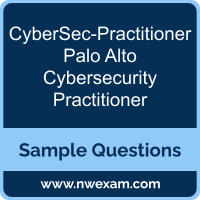01. Why is compliance management important in cloud security?
a) It ensures cloud services adhere to regulatory frameworks like GDPR and HIPAA
b) It replaces the need for endpoint security
c) It prevents all unauthorized access
d) It eliminates the need for threat detection
02. What differentiates a SIEM from a SOAR platform?
a) SOAR platforms do not integrate with SIEM solutions
b) SIEM replaces the need for firewalls
c) SIEM collects and analyzes security logs, while SOAR automates incident response workflows
d) SIEM automatically responds to all security threats
03. Which of the following best describes a DDoS botnet?
a) A network of infected devices used to overwhelm a target system with excessive traffic
b) A system that spreads spam emails to trick users into installing malware
c) A botnet designed to steal financial credentials from infected devices
d) A botnet used exclusively for cryptocurrency mining
04. How does DNS Security prevent cyber threats?
a) It encrypts all DNS requests automatically
b) It blocks malicious domains and prevents DNS tunneling attacks
c) It acts as a firewall replacement
d) It stores all DNS logs for compliance auditing only
05. Attackers often use port evasion techniques to bypass network security devices. Which method is a common example?
a) Blocking all outgoing traffic on TCP 80
b) Sending attacks only during weekends
c) Disabling firewall rules to create an open path
d) Using port 443 (HTTPS) to carry malicious payloads disguised as encrypted web traffic
06. What is a key benefit of using Cortex Xpanse (ASM)?
a) Replacing endpoint security solutions
b) Blocking all unauthorized web traffic automatically
c) Providing continuous visibility into an organization’s exposed assets and potential security risks
d) Managing user authentication policies
07. A company experiences a sudden system lockdown, followed by a demand for cryptocurrency payment to regain access to their data. What type of attack is occurring?
a) Ransomware
b) DDoS Attack
c) Spyware Infection
d) SQL Injection
08. How does a SIEM platform improve security event analysis?
a) It automatically prevents malware infections
b) It replaces traditional endpoint detection and response (EDR) solutions
c) It only stores logs for compliance audits
d) It aggregates, normalizes, and correlates security events from multiple sources to identify threats
09. Your company’s HR department reports an email requesting employee tax records, appearing to come from the CEO. However, the email address domain is slightly different from the company’s official domain.
What type of phishing attack is this?
a) Business Email Compromise (BEC)
b) Vishing
c) Clone Phishing
d) Smishing
10. An unauthorized user attempts multiple login attempts across various endpoints in an organization. How can Cortex XDR help mitigate this threat?
a) By manually reviewing all login logs every week
b) By detecting abnormal login behavior and automatically triggering response actions
c) By encrypting all stored passwords
d) By blocking all network activity for legitimate users
 Before you write the Palo Alto CyberSec-Practitioner certification exam, you may have certain doubts in your mind regarding the pattern of the test, the types of questions asked in it, the difficulty level of the questions and time required to complete the questions. These Palo Alto Networks Certified Cybersecurity Practitioner sample questions and demo exam help you in removing these doubts and prepare you to take the test.
Before you write the Palo Alto CyberSec-Practitioner certification exam, you may have certain doubts in your mind regarding the pattern of the test, the types of questions asked in it, the difficulty level of the questions and time required to complete the questions. These Palo Alto Networks Certified Cybersecurity Practitioner sample questions and demo exam help you in removing these doubts and prepare you to take the test.